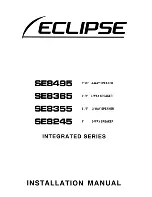
Xcn T
w
o
-W
ay MB/HF System
Xcn Two-Way MB/HF System
3
93-volts rms short term
132-volts peak
MB:
800 watts per channel
into 8 ohms
93-volts rms short term
132-volts peak
Xcn loudspeakers may be paralleled with
other Xcn systems as long as the amplifi-
ers can drive the lower impedances. To
maintain a sufficient damping factor with
long cable runs, amplifier loads of four
ohms per channel are recommended. The
Electro-Voice P3000 amplifiers are ideal for
powering the X-Array™ systems.
Crossover, Equalization and Signal
Delay Controller
The Xcn is a two-way active loudspeaker
system requiring an active crossover,
equalization and signal delay controller.
For basic applications, the Electro-Voice
Dx38 2-in/4-out controller is recommended.
For more sophisticated applications, the
Klark Teknik DN8000 2-in/ 5-out controller
is recommended. Linkwitz-Riley crossover
filters with a minimum slope of 24-dB per
octave at 125 Hz and 1,760 Hz are recom-
mended. Both the Dx38 and the DN8000
offer appropriate filtering, equalization and
signal delay capabilities to provide opti-
mum performance of the X-Array™ loud-
speaker systems. Digital parameter settings
for both controllers are available upon
request.
Electrical Connection and System
Wiring
Two paralleled Neutrik 8-pin Speakon
®
connectors are used for electrical connec-
tion to the Xcn loudspeakers with the fol-
lowing pin assignments:
HF:
Pins 4 Paralleled
MB:
Pins 3 Paralleled
The Xcn wiring diagram is shown in Fig-
ure 7. Since the connectors are paralleled,
it does not matter which connector is used
as the input or output when paralleling Xcn
systems. Although Pins 1 and 2 are not
used by the Xcn systems, they are paral-
leled on the input panel. This allows an X-
Array™ bass box (like the Xb or Xcb –
which use Pins 1 and 2, but not Pins 3 and
4) to be paralleled with an Xcn, allowing all
eight conductors to be used with a single
cable run to the amplifiers. Note that when
four Xcn systems are jumped from one to
another, the amplifier home-run cable will
have four high-frequency drivers on Pins
4 (for a 4-ohm load) and four mid-bass driv-
ers on Pins 3 (for a 4-ohm load).
Flying the X-Array™ Systems
The X-Array™ loudspeaker systems all
utilize the same rigging hardware and have
the same structural strength ratings. Thus,
different systems may be mixed in an array
to achieve the best acoustic results. The
rigging system allows for the smallest pos-
sible spacing between adjacent enclosures,
and utilizes quick-release rigging fittings
for fast installation and tear down.
When flown, the X-Array™ enclosures are
linked together by two removable hinges
on the rear of the enclosures at the top and
bottom. This arrangement enables the en-
closures to pivot vertically from the rear
corners. The relative vertical angle between
adjacent enclosures is adjustable and set
by two removable rigging straps on the
front of the enclosures at the top and bot-
tom. Both the rear rigging hinges and the
front rigging straps are installed when en-
closures are sitting on top of one another.
For ease of installation of the hinges and
straps, the enclosures self align using feet
and cups mounted on the top and bottom
of the enclosures. The relative horizontal
angle between adjacent columns of loud-
speakers is set by adjustable grids at the
top of the array (or by custom-building at-
tachment supports in permanent-installa-
tion applications where grids are not used).
The removable proprietary rear rigging
hinges utilize all-steel construction and are
secured into a proprietary track assembly
on the enclosure (similar to the heavy-duty
aircraft L-track). The aluminum track is ex-
truded as a single-piece track/angle-bracket
assembly and ties into the top, bottom and
rear of the enclosure. Metal bars inside the
enclosure tie the top and bottom track/
angle-bracket assemblies together, minimiz-
ing the load applied to the wooden enclo-
sure. The rear extrusion will accommodate
the New Haven 32102-2 aircraft-type
double-stud locking fitting instead of the
hinge for applications requiring a lower
strength rating.
The removable front strap assemblies uti-
lize all-steel New Haven 32102-2 aircraft-
type double-stud locking fittings and wire
rope, and are secured into another propri-
etary track similar to the heavy-duty air-
craft L-track. The track is extruded as a
single-piece track/angle-bracket assembly
that ties into the front and side of the en-
closure. The track/angle-bracket assembly
extends from the top to the bottom of the
enclosure, eliminating the load applied to
the wooden enclosure.
A complete line of flying-hardware acces-
sories is available for the X-Array™ loud-
speaker systems including a grid, rigging
hinges and rigging straps. The variety of
rigging hinges and front rigging straps
available include those for linking two en-
closures together, securing the top enclo-
sure in a column to a grid, and for picking
up the top enclosure in a column without a
grid. Consult the X-Array™ Accessories
section for a complete listing the available
rigging accessories.
The total weight of a column of X-Array™
loudspeaker systems that may be sup-
ported by the X-Array™ rigging system
varies from 454-726 kg (1,000-1,600 lb) de-
pending on the rigging configuration de-
tails. An X-Array™ Flying Manual is
available from Electro-Voice and is included
with each X-Array™ system shipment. The
manual should be consulted for complete
structural specifications and detailed in-
structions for safely suspending and us-
ing the X-Array™ systems.
Field Replacement
Normal service for the Xcn requires only a
#2 Phillips screwdriver and a 3/16-inch hex-
key wrench. The drivers may be accessed
as follows:
HF: First remove the grille, then remove
the screws securing the front flange of the
high-frequency horn. Lift the horn and
driver out of the shroud assembly. In the
event of failure, the diaphragm assembly






























